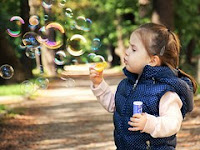Bubbles are universal fun for young and old alike. Something about that iridescent floating orb
evokes memories of reaching for the sky and imaginary worlds beyond the rainbow.
Most children learn to purse their lips and blow around 3 years old.
 |
| Learning to Blow Bubbles |
Holding a full jar of bubbles
and trying to keep it level while inserting the bubble wand is usually a skill
not mastered until 6 or 7.
That’s not to
say that young children can’t enjoy bubbles, but they require adult supervision
if it is to be a successful adventure that doesn’t lead to a total mopping of
the floor!
I personally love the “spill proof” bubble containers, as
the unique design of the container lid reduces the spillage of liquid to a
minimum.
 |
| Unique Spill-Proof Bubble Bucket |
I prefer to instruct children ahead of time to get out their
“pointy fingers” (index fingers) and try to stand in one spot and pop the
bubbles.
 |
| BOP Goes the Bubble! |
 |
| Reaching up for Bubbles |
Even infants can enjoy bubble play. It helps develop early focus and tracking, reaching, language, and cognitive Skills. If an adult is able to blow and then catch a bubble on the wand,
it can be placed within the baby’s visual range and moved to facilitate focus and tracking. The child can be encouraged to reach out a hand or finger to pop the bubble, working on the development of core control, isolation of upper extremity movement from the trunk, and fine motor control.
 |
| Catch Bubbles on the Wand so Young Children can Enjoy! |
Large bubbles made with a bubble wand are
great fun outdoors. Adults or patient
older children can learn to make these gigantic bubbles with a bit of
practice.
Bubbles that can be touched and stacked are also available
and are sold under a variety of names such as “Catch-a-Bubble”,
“Stack-a-Bubble” and “Touchable Bubbles”.
These are great bubbles, as they usually don’t pop until
touched and will float in the air for long periods of time, allowing young
children and children with speed and control issues a higher chance of
successfully capturing or popping the bubbles.
This type of bubble should be blown by adults or older children, as
spills are very sticky and difficult to clean. They are non-toxic and do not stain furniture or
floors, although they do leave a cobweb-like residue that easily wipes away.
So choose your bubbles, whip out the wand and turn on the
smiles and laughter.
Author: Trisha Roberts













No comments:
Post a Comment